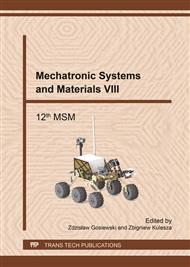p.156
p.175
p.187
p.194
p.202
p.212
p.219
p.227
p.235
Theoretical Approach of Wear for Slide-Friction Pairs
Abstract:
A number of different mechanisms and devices in mechatronic systems may involve sliding-friction surfaces. The issues of service life and its prediction for the details of such surfaces have always been of particular importance. Having studied the wear process prediction theories that have been developed in the course of time, which can be classified by dividing them in definite groups based on similar theoretical approach one can state that each of them has different shortcomings, which might affect the result precision, when essential basic parameters have been disregarded, as well as create a need for useless additional practical experiments, as a result of which theoretical calculation becomes unnecessary. [4] The article determines the most suitable wear calculation model that allows considering the set of parameters necessary for calculating slide-friction pair. Wearing usually proceeds in three stages: the running-in stage, the normal wear stage, and the intensive wear stage. The proposed model is provided for normal wear stage calculations. The proposed model for wear calculation is based on the application of theories from several branches of science to the description of 3D surface micro-topography in accordance with random field theory, assessing the material’s physical and mechanical characteristic quantities, substantiating the regularities in creation of material particles separated during the wear process and taking into consideration definite service conditions of fittings. Since the wear process is variable and many-sided, it is influenced by numerous different parameters, for example, surface geometry (roughness, waviness, form deviation, etc.), physical and mechanical conditions of the upper layer, material components, wear regime, wear temperature, etc. Based on the regularities stated in the article one can propose the following wear calculation sequence [4]:1) Initial data should be stated which will be further necessary in calculations: constructive-kinematic characteristic quantities (rated area Aa of wearing component, load P, gliding movement speed v, movement time t), fatigue characteristic of friction component material (friction coefficient f (f≤0,1) and material fatigue destruction parameters (m, σ-1, N0), mechanical characteristic quantities of material (E, μ);2) Parameters should be stated after attachment: surface roughness parameters (Sa, Sm1, Sm2, Sm2a), initial wear Up and corresponding time Tp, tolerated wear Umax.
Info:
Periodical:
Pages:
202-211
Citation:
Online since:
July 2017
Authors:
Keywords:
Price:
Сopyright:
© 2017 Trans Tech Publications Ltd. All Rights Reserved
Share:
Citation:


